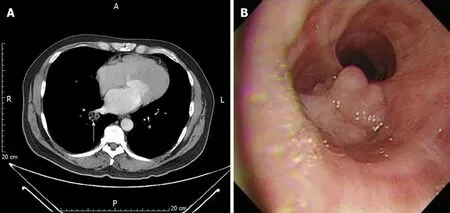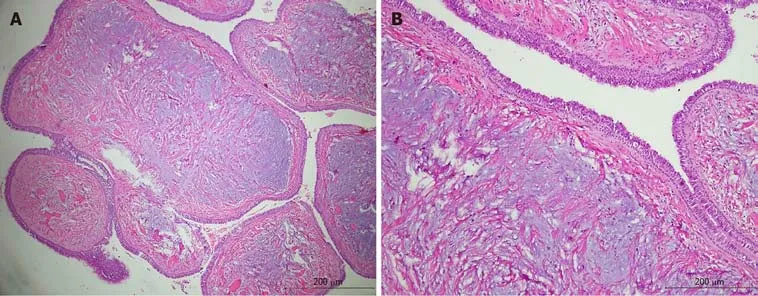Diagnosis and management of glandular papilloma of lung: A case report
2020-04-25ChienWeiWuAnnChenTsaiWangHuang
Chien-Wei Wu,Ann Chen,Tsai-Wang Huang
Chien-Wei Wu,Department of Surgery,Tri-Service General Hospital,Taipei 114,Taiwan
Ann Chen,Department of Pathology,Tri-Service General Hospital,Taipei 114,Taiwan
Tsai-Wang Huang,Division of Thoracic Surgery,Department of Surgery,Tri-Service General Hospital,Taipei 114,Taiwan
Abstract
BACKGROUND
Solitary respiratory papilloma is a rare epithelial tumor that can be categorized into multiple subtypes depending on tumor location,histological presentation and number.The glandular type is the rarest,with only 30 cases available within the field.Hence,information on its identification and treatment is limited.In this report,we discuss the diagnostic strategy and management of glandular papilloma,along with a review of the literature.
CASE SUMMARY
We describe a male 44-year-old nonsmoker who presented with a persistent cough and recurrent pneumonia,which he had experienced for over 2 years.A solitary pulmonary nodule with an endobronchial lesion was found via computed tomography of the chest.After a biopsy was obtained,no definite diagnosis could be made.Glandular papilloma of the lung was confirmed via videoassisted thoracoscopic anatomic resection of the right lower lobe of the lung.The patient remained disease-free after 6 mo follow up.
CONCLUSION
Minimally invasive surgery is feasible for the surgical resection of endobronchial glandular papilloma.Although rare,glandular papilloma should be considered in patients with infection or endobronchial lesions.
Key words:Papilloma;Lung;Treatment;Minimal invasive surgery;Diagnosis;Case report
INTRODUCTION
Solitary papilloma of the lung is a rare epithelial tumor,with an estimated incidence of 3.95 cases/100000 patients annually[1].It is categorized into three types based on histology: The squamous,glandular,and mixed.Glandular papillomas are the rarest form of solitary papillomas.They occur predominantly in the central tracheobronchial tree,arising from the mucosal surface.The imaging of these tumors usually shows atelectasis,air-trapping,obstructive infections,and bronchiectasis.It is important to distinguish glandular papillomas tumors from active inflammation,granulomatous disease,carcinoids,and lung cancer due to its different prognosis.To confirm a diagnosis preoperatively,bronchoscopic biopsy or computed tomography-guided biopsy is needed.The most common reported symptom of glandular papillomas is coughing[2].Histologically,ciliated cells,simple columnar cells,or mucous cells with a central fibrovascular core cover the cells of these tumors.There are no reports that suggest malignant transformation occurs.Treatment is dependent upon the case,for example,surgical resection is required in patients with severe symptoms.We report a case of glandular papilloma of the lung in a 44-year-old non-smoker and discuss the diagnostic strategy and management with minimally invasive uniportal videoassisted thoracoscopic surgery,along with a review of the literature.
CASE PRESENTATION
Chief complaints
A 44-year-old Taiwanese male,an office worker,represented to us with a 2-year history of a productive cough.
History of present illness
He had experienced 3 episodes of pneumonia in the previous 2 years.After empiric treatment with antibiotics including levofloxacin 750 mg PO for 1 wk in the past 3 episodes,the symptoms subsided.At the time of presentation,the patient seemed uncomfortable and feverish.
History of past illness
He had been healthy before the cough developed.
Personal and family history
He was a non-smoker and no specific family history.
Physical examination upon admission
Physical examination showed decreased breathing in the right lower lung field.
Laboratory examinations
Serum laboratory data,including tumor markers such as carcinoembryonic antigen(1.91 ng/mL) and anti-squamous cell carcinoma antigen antibody(0.60 ng/mL),were within normal limit.
Imaging examinations
A plain chest radiograph demonstrated focal atelectasis of the right lower lobe of the lung.Contrast-enhanced thoracic computed tomography was also performed,and revealed bronchiectasis,right lower lobe,and a nodule with a lower density material over the right hilar region(Figure 1A).The differential diagnosis included hematoma or mucoid impaction soft-tissue lesions(Figure 1A).

Figure 1 Computer tomography and bronchoscopy.
Bronchoscopy revealed an endobronchial lobulated protruded mass in front of bronchi 9 and 10(Figure 1B).An endobronchial biopsy was performed with forceps.The pathological report revealed atypical cell nests with hyperchromatic nuclei.But it did not lead to a diagnosis.Therefore,he underwent surgical intervention.The final pathological report revealed glandular papilloma of lung.
FINAL DIAGNOSIS
Glandular papilloma of lung.
TREATMENT
The patient underwent right lower lobe lobectomyviauniportal video-assisted thoracoscopic surgery.Initially,we attempted basal segmentectomy,but converted to right lower lobectomy because the tumor was very close to the orifice of B6 bronchus.The endobronchial tumor was yellow and firm,and was located at the proximal right lower lobe bronchus.An endobronchial tumor was also observed.A frozen section of the tumor revealed glandular papilloma.Hematoxylin and eosin staining revealed bland pseudostratified columnar cells with cilia admixed with occasional mucous cells,accompanied by a fibrovascular core and an underlying myxoid stroma,compatible with glandular papilloma of the pulmonary tissue(Figure 2A).In addition,mucus production and some cartilage was noted(Figure 2B).
OUTCOME AND FOLLOW-UP
Postoperatively,the patient was discharged within 4 d.No complications were noted.At 6 mo postoperatively,the patient has remained clinically and radiographically disease-free.
DISCUSSION
The incidence of lung cancer differs across countries.Respiratory papillomas are extremely rare,benign epithelial tumors.Solitary endobronchial papillomas constitute only 0.38% of all lung tumors and about 7% of all benign epithelial and mesenchymal lung tumors[3].
Based on number,location,or histology,pulmonary papillomas can be classified into a few subtypes.According to the number of lesions,they are divided into two types: Multiple and solitary papillomas.Multiple papillomas,representing papillomatosis,are usually related to infection with papillomavirus which occurs most often in children and young adults and involves both the upper and lowerrespiratory tracts.Solitary papillomas are rare and predominantly affect adults.Pulmonary papillomas can be classified as central or peripheral based on bronchiolar tumor location.Majority of peripheral bronchiolar papillomas are small,asymptomatic,and are only discovered incidentally on chest radiography.Pulmonary papillomas are histologically divided into three categories: squamous cell,glandular,and mixed types.Squamous cell papillomas are the most common,and glandular papillomas of the lung seem to be rare.

Figure 2 Histopathology.
We reported a case of glandular papilloma of the lung with a good outcome after right lower lobe lobectomyviauniportal video-assisted thoracoscopic surgery.The preoperative evaluation of pulmonary papillomas is very difficult,especially for this tumor subtype.We reviewed articles that mentioned glandular papilloma from 1954 to 2019.Only 30 cases have been published;83%(25/30) of patients in these reports had undergone an operation for the confirmation of a diagnosis or to relieve severe obstructive symptoms[4].In our case,the patient was successfully treated by right lower lobectomyviauniportal video-assisted thoracoscopic surgery.To the best of our knowledge,malignant transformation has only been reported with the squamous variant of this epithelial tumor.The glandular variant does not appear to recur locally after excision and has no proven malignant potential[4].However,it was difficult to distinguish the subtype of this tissue by preoperative evaluation.After considering the obstructive symptoms and the purpose of diagnosis,anatomic resection with adequate margins can result in long-term,disease-free survival.Due to the development of thoracoscopic techniques,we reported a minimally invasive surgery for treating glandular papilloma.
CONCLUSION
In conclusion,minimally invasive surgery is feasible for the surgical resection of endobronchial glandular papilloma.Although rare,it is important to consider glandular papilloma in patients with infection or endobronchial lesions.
杂志排行
World Journal of Clinical Cases的其它文章
- Gut microbiota and nutrient interactions with skin in psoriasis: A comprehensive review of animal and human studies
- Microbiota-gut-brain axis and its affect inflammatory bowel disease:Pathophysiological concepts and insights for clinicians
- Distal esophageal spasm: Update on diagnosis and management in the era of high-resolution manometry
- Clinical course of percutaneous cholecystostomies: A crosssectional study
- Clinical characteristics and 28-d outcomes of bacterial infections in patients with hepatitis B virus-related acute-on-chronic liver failure
- Application of hybrid operating rooms for treating spinal dural arteriovenous fistula
